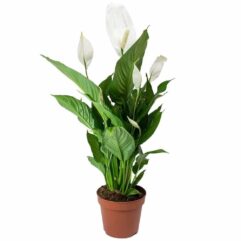3G cutting is word that most of us have heard in different agricultural practices but very few of us know about its actual meaning and process. People are unaware of the benefits of 3g cutting because they are not applying it.
Revolutionary Technique for Doubling Yield in Cucurbit Crops
Due to haphazard use of chemical pesticides, the beneficial insects responsible for pollination are sharply decreasing. As a result, very poor pollination takes place in Cucurbitaceae crops. Cucurbit includes cucumber, sponge gourd, bottle gourd, bitter gourd, snake gourd, pumpkin, ridge gourd, ash gourd and many more. There is increasing problem of low fruit set and if there is fruit set; very small fruits are developed that are deteriorated in the mother plant. Most farmers of world including Nepal too are suffering from this problem.
-
 test productSale!
test productSale!Rs.10.00Rs.1.00 -
 Spathiphyllum or spath or peace lilies Live PlantSale!
Spathiphyllum or spath or peace lilies Live PlantSale!Rs.1,000.00Rs.850.00 -
 Thai all season grafted mango plant for pot and gardenSale!
Thai all season grafted mango plant for pot and gardenSale!Rs.2,250.00Rs.1,750.00
What is 3G Cutting?
3G cutting is such a powerful toolkit in agriculture that can be used to produce optimum production per unit area of land. 3G refers to simply 3rd (Third generation) in any crop i.e. promoting the growth of third (tertiary) branch excluding the 1st & 2nd generation branches. With the seed germination only one main branch continues to grow which is defined is 1st (First generation). If this first branch gives another branch then it is defined as 2nd (Second generation). Further when this 2nd generation branch gives another branch, it is said as 3rd (Third generation).
According to the research studies, the 1st & 2nd generation branches comprise majority of Male flowers rather than female leading to very small ratio of 14:1 (Male: Female) flowers in the branch that creates us false illusion of heavy flowering but with very low fruiting. Thus, 3rd generation branches flush with majority of female flowers. In accordance with proper pollination at this condition it results higher fruit set per branch & finally per plant which ultimately leads to higher production/yield per branch or per plant. The main aim should be focused in keeping 3rd generation branch rather than others.
Steps of 3G Cutting:
3G cutting is very necessary inter-culture in growing cucurbits & very slight influence in tomato which seems easy rather being sensitive at field work.
• Initially, the main branch growing from the sown seed must be allowed to grow properly with close carefulness.
• After the main branch reaches the height of about 7-8 ft (gourds) or 5-6 ft (cucumber & pumpkin), cut the tip growing part of plant about 4-5 inches.
• After the apical part is removed it promotes the growth of secondary branch. This is because of translocation of photosynthesized food to the secondary branch.
• Now, after the secondary generation branch has grown upto 2-3 ft height, then the upper apical part of this branch also should be removed as the previous one. This will now promote the growth of tertiary branch or third generation branch.
• Now, the third-generation branch should be allowed to grow with optimum fertilization of nutrients. This will lead to heavy flowering of female flowers in the plant.
Objectives of 3G Cutting
The main objective of 3G cutting is maintaining of proper ratio of male and female flowers in plant from which the optimum production can be harvested. And increasing the crop production exponentially.
Special Attention:
- Make sure that lower 4-5 leaves of plant do not bear any branches i.e. secondary branches.
- Cut the apical part of second-generation branches at 12 leaves stage i.e. just above the 12th leaf.
- Main branch apical part must be cut off when plant height reaches at 7-8 ft tall.
-
 test productSale!
test productSale!Rs.10.00Rs.1.00 -
 Spathiphyllum or spath or peace lilies Live PlantSale!
Spathiphyllum or spath or peace lilies Live PlantSale!Rs.1,000.00Rs.850.00 -
 Thai all season grafted mango plant for pot and gardenSale!
Thai all season grafted mango plant for pot and gardenSale!Rs.2,250.00Rs.1,750.00
3G cutting is very new and innovative technique of interculture or cutting in cucurbit crops and solely new in country like Nepal. In fact this technique is very advantageous and useful to farmers from profit making point of view.
Source:
https://agritechnepal.com/2020/05/3g-cutting-revolutionary-technique-for-doubling-yield-in-cucurbit-crops/
